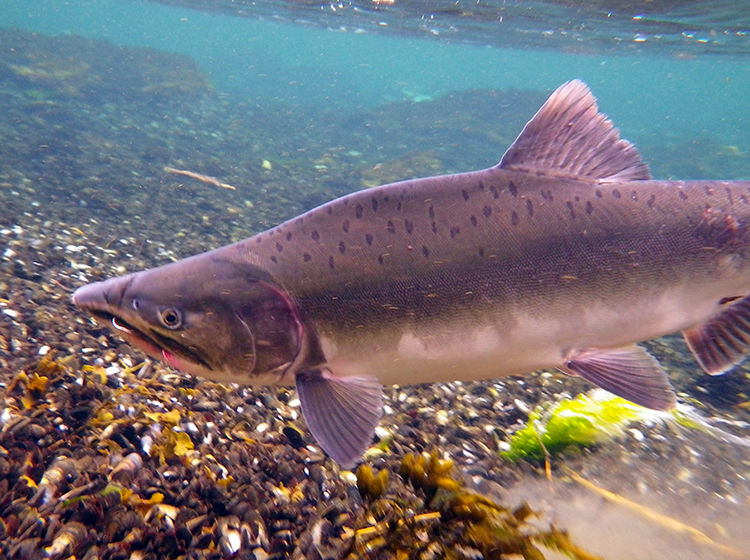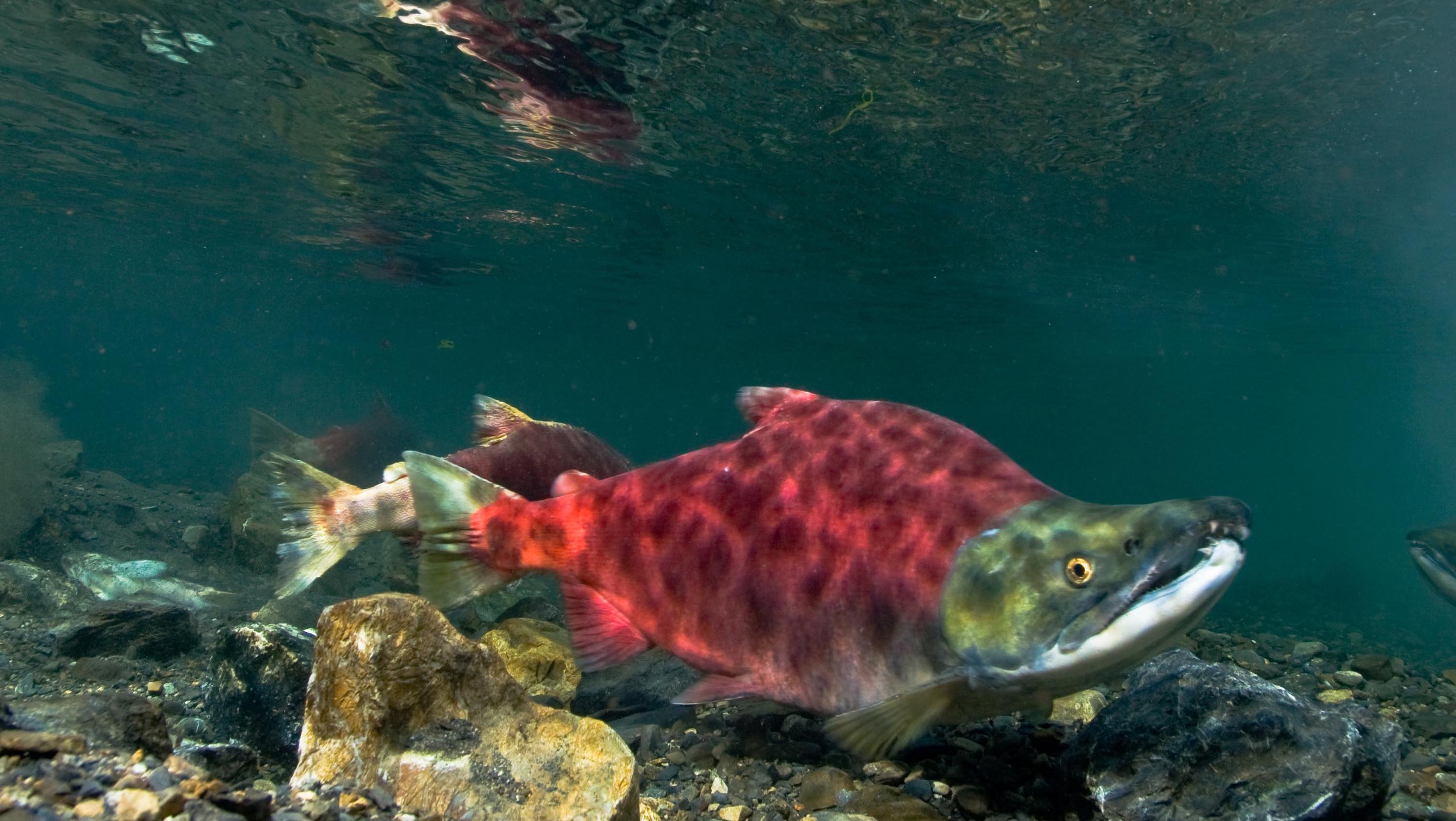Salmon is a popular fish that is enjoyed by many people around the world. However, not many people know that there are actually several species of salmon.
In North America alone, there are six types of salmon, five of which live in the Pacific Ocean and one in the Atlantic Ocean. Each type of salmon has its own distinctive features, such as size, color, and flavor. Knowing the differences between the species can be helpful for fishing or cooking purposes.
You are reading: Types Of Salmon And Their Distinctive Features
In this article, we will explore the six types of salmon and their distinctive features.

6 Types Of Salmon And Their Distinctive Features
Chinook Salmon/King Salmon

Chinook salmon, also known as King salmon, is the largest of all Pacific salmon species. They are typically found in the northern Pacific Ocean, from California to Alaska and across the Bering Sea to Asia.
Chinook salmon can grow up to 4.9 feet long and weigh up to 129 pounds, but the typical length and weight of mature fish are about 3 feet and 30 pounds. Females can be distinguished by their torpedo-shaped body, robust mid-section, and blunt nose. Juveniles in freshwater have well-developed parr marks on their sides.
Chinook salmon are anadromous, meaning they hatch in freshwater streams and rivers, then migrate out to the saltwater environment of the ocean to feed and grow.
Chinook salmon have a pronounced buttery, rich taste and are the most highly prized salmon in the culinary world. The meat is almost always red, never pink, except for the rare white-meat variety. Chinook salmon is low in sodium and is a good source of omega-3 fatty acids.
Sockeye Salmon/Red Salmon

Sockeye salmon, also known as red salmon, is a Pacific salmon species found in the Northern Pacific Ocean and rivers discharging into it. They are one of the smaller species of Pacific salmon, measuring 18 to 31 inches in length and weighing 4-15 pounds.
Sea-going sockeye salmon have iridescent silver flanks, a white belly, and a metallic green-blue top, giving them their “blueback” name. During spawning, their bodies turn bright red and their heads take on a greenish color, hence their other common name, “red” salmon.
Breeding-age males develop a humped back and hooked jaws filled with tiny, visible teeth. Juveniles, while in freshwater, have dark, oval parr marks on their sides. Sockeye salmon are prized for their firm, bright-orange flesh and are the reddest of all the wild salmon species.
The striking orange color of sockeye salmon flesh comes from eating plankton and krill while in the ocean. Sockeye salmon is low in sodium and is a good source of omega-3 fatty acids.
Coho Salmon/Silver Salmon
Read more : Discover The 2 Types Of Possums
Coho salmon, also known as silver salmon, is a Pacific salmon species found in the Northern Pacific Ocean and rivers discharging into it. They are called “silvers” because of their silver sides during their ocean phase.
Coho salmon have dark metallic blue or greenish backs with silver sides and a light belly. During their spawning phase, their jaws and teeth become hooked, and they develop bright-red sides, bluish-green heads and backs, dark bellies, and dark spots on their backs.
Sexually maturing fish develop a light-pink or rose shading along the belly, and the males may show a slight arching of the back. Juveniles, while in freshwater, have dark, oval parr marks on their sides.
Coho salmon is a game fish in fresh and salt water from July to December, especially with light fishing tackle. It is one of the most popular sport fish in the Pacific Northwest of the United States and Canada.
Coho salmon has a milder flavor than other types of salmon and is often used in sushi. Its orangey-red flesh has a firm texture, making it a good type of salmon for grilling. Coho salmon is high in anti-inflammatory fats and is a good source of omega-3 fatty acids.
Pink Salmon/Humpback Salmon
Pink salmon, also known as humpback salmon, is the smallest and most abundant of the seven officially recognized species of salmon. They are found in the northern parts of the Pacific Ocean and rivers discharging into it.
Pink salmon weigh on average between 3.5 and 5 pounds and have an average length of 20-25 inches. They are coldwater fish and are the most numerous Pacific salmon.
Young pink salmon are completely silver without any dark vertical bars or spots, while adults are bright greenish-blue on top and silvery on their sides. During their spawning migration, males develop a pronounced humped back, hence their other common name, “humpback” salmon.
Breeding males also develop a large hump on their back, which is why they are often called “humpback” salmon. Pink salmon can be distinguished from other Pacific salmon by the large dark oval spots on their back and entire tail fin as well as their general coloring and form.
Pink salmon is a North Pacific food fish, weighing about 2 kilograms (4 1/2 pounds) and marked with large, irregular spots. It often spawns on tidal flats, and the young enter the sea immediately after hatching.
Chum Salmon/Dog or Keta Salmon/Silverbrite
Chum salmon, also known as dog salmon or keta salmon, is a species of anadromous salmonid fish from the genus Oncorhynchus. They are native to the coastal rivers of the North Pacific and the Beringian Arctic. Chum salmon is often marketed under the trade name silverbrite salmon in North America.
Chum salmon is the most widely distributed of all the Pacific salmon and generally occurs throughout Alaska. Chum salmon is one of the largest species of Pacific salmon, second only to Chinook salmon in size.
When in the ocean, chum salmon are metallic greenish-blue along the back with black speckles, similar to both sockeye and coho salmon. During their spawning migration, males develop a pronounced humped back, hence their other common name, “humpback” salmon.
Chum salmon is usually known as dog salmon or commonly referred to as silverbrite salmon. Chum salmon is a North Pacific food fish, weighing about 2 kilograms (4 1/2 pounds) and marked with large, irregular spots.
Read more : 11 Types Of Crabs Crawling Florida’s Beaches
Chum salmon is low in sodium and a good source of omega-3 fatty acids, protein, niacin, vitamin B12, and selenium.
Atlantic Salmon
Atlantic salmon (Salmo salar) is a species of ray-finned fish in the family Salmonidae. It is the third largest of the Salmonidae, growing up to a meter in length.
Atlantic salmon are found in the northern Atlantic Ocean and in rivers that flow into it. Most populations are anadromous, hatching in streams and rivers but moving out to sea as they grow where they mature, after which the adults seasonally move upstream again to spawn.
Atlantic salmon is considered a very healthy food and one of the fish with a more refined taste in many cultures. As such, it features in numerous popular traditional cuisines and can fetch a higher price than some other fish. Atlantic salmon are a cold-water fish species and are particularly sensitive to changes in water temperature.
Atlantic salmon are important oceanic prey for several species and were historically an important fishery species. Atlantic salmon fisheries have been regulated for at least 800 years in Europe.
While they migrate toward their spawning grounds, Atlantic salmon are targeted by fishers using traps and other semi-permanent structures installed in rivers.
Atlantic salmon are one of the most aquacultured marine fishes and are farmed in many places around the world, including outside of their native range. Now, essentially all of the Atlantic salmon sold in the seafood industry is from farms rather than from wild populations.
FAQS
1. How many types of salmon are there?
There are six types of salmon in North America, five of which are Pacific salmon and one is Atlantic salmon.
2. What are the six types of salmon?
The six types of salmon are Chinook salmon/King salmon, Sockeye salmon/Red salmon, Coho
salmon/Silver salmon, Pink salmon/Humpback salmon, Chum salmon/Dog or Keta salmon/Silverbrite, and Atlantic salmon.
3. What are the distinctive features of Chinook salmon/King salmon?
Chinook salmon is the largest of all the salmon in the world, often weighing over 100 pounds and can be up to five feet long. They have golden eyes that are much bigger and more prominent than those of other types of salmon. They have white gums and a white interior of the mouth. These salmon do not have any spots on their tails or backs. Each of these fish has 30 to 40 long, serrated gill rackers.
4. What are the distinctive features of Sockeye salmon/Red salmon?
Sockeye salmon has a bright red flesh and is known for its rich flavor. They are smaller than Chinook salmon, weighing between 4 and 15 pounds. They have a metallic green-blue back and silver sides. During spawning, their bodies turn bright red and their heads turn green.
5. What are the distinctive features of Coho salmon/Silver salmon?
Coho salmon has a milder flavor than other types of salmon and is often used in sushi. They have a metallic blue-green back and silver sides. During spawning, their bodies turn bright red and their heads turn green.
6. What are the distinctive features of Pink salmon/Humpback salmon?
Pink salmon is the most abundant of the seven species of Pacific salmon. They have very light-colored and mildly flavored flesh and low-fat content. During spawning, males develop a distinctive hump on their backs.
7. What are the distinctive features of Chum salmon/Dog or Keta salmon/Silverbrite?
Chum salmon has a mild flavor and is often used for canning. They have a metallic green-blue back and silver sides. During spawning, males develop distinctive vertical bars on their sides.
8. What are the distinctive features of Atlantic salmon?
Atlantic salmon is traditionally found in the Atlantic Ocean. They have a mild flavor and are often farmed. They have a metallic blue-green back and silver sides.
9. Which type of salmon is the healthiest?
All types of salmon are healthy and a good source of protein and omega-3 fatty acids. However, the fat content and flavor can vary between species.
Source: https://petstutorial.com
Category: Animals










